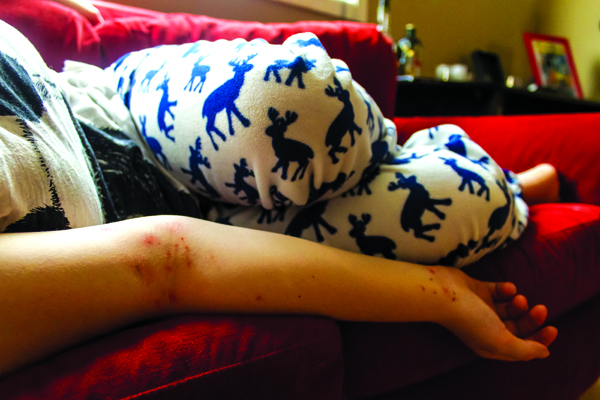How to spot, eradicate, and prevent bed bug infestations
Photo by Tina Wallace
Discovering the bugs
In November 2009, I called my mother in Toronto to catch up. I fell into bed and rolled over, absentmindedly playing with a stray thread in my pillowcase as we chatted. That’s when I noticed that the little red flowers on my blue striped pillowcase were moving.
Even though I had never seen any before, I knew right away they were bed bugs. I screamed, wiggled, jumped around, and stripped buck naked while standing in my bathtub, sobbing to my mother about how disgusting I must have been for getting bed bugs.
After the initial panic and my first sleepless night, I had an overwhelming desire to throw away all of my belongings. Suddenly, my expensive dress clothes, my grandma’s table, and my university textbooks seemed easily disposable.
Bed bugs live in your furniture, floorboards, books, computer, purses, and suitcases. They love small dark cracks in materials like wood, fabric, and paper. They hide in these miniscule cracks all day, until dark, when they emerge to feed on human blood. My blood was the only reason those little suckers were alive—growing from one growth stage to the next—and reproducing. In her lifetime, one female can lay hundreds of eggs.
It turns out that the little bugs on my pillow were nymphs—a name for recently hatched bed bugs. According to Ottawa Valley Pest Control, adult bed bugs are reddish brown and about five millimetres long, and rarely come out in the light. Nymphs are much more likely to crawl around before it’s completely dark.
Bed bugs only come out in the middle of your sleep cycle. Light or dark, they are happy to adjust to your schedule and alter their feeding cycle. For this reason, it is extremely rare to see them with the naked eye. Unlike my experience, most people notice evidence of bed bugs before the actual bugs themselves because they are so tiny.
Small black dots on porous surfaces are telltale signs of bed bugs. Picture someone dotting your mattress or bed frame with a fine-tip sharpie. This is bed bug scat, or feces. When a bed bug grows, it sheds the outer layer of its exoskeleton, so you may also see these dried skins on the floor or in your bed frame. They are clear or white and are only present near where the bed bugs hide.
Bites comparable to mosquito bites are the most common sign that your place is infested. Bed Bugs Info, a website recommended for research by Health Canada states that “most bed bug bites are initially painless, but could turn into large, itchy skin welts. Some people have no reaction at all. Most bed bug bites eventually go away by themselves and don’t need treatment.” Generally, bed bug bites can be found on the shoulders and back.
If you have them
Although bed bugs are really hard to get rid of, it is possible to eradicate them. Stay calm and do your research. When I had them, I was frustrated when I couldn’t see immediate results. Remember that it takes time, and if you’re vigilant, they can be killed off completely.
As soon as you see signs of bed bugs, talk to your landlord and roommates. Don’t wait until you see a bug. Instead, demand that your landlord call the exterminator for an inspection. The Ontario Residential Tenancies Act states that your landlord has an obligation to maintain your unit in “a good state of repair and fit for habitation.” Likewise, upon discovery, you have an obligation to promptly report bed bugs to your landlord.
An exterminator will begin by evaluating exactly how large the infested area is. I caught mine early, so it was relatively contained; the bugs were only located in my sleeping area. They may be called bed bugs, but that certainly isn’t the only furniture they want to live in. Carefully check the seams of your sofa, around your floorboards, and any other furniture with small crevices.
The next step is ensuring that all your personal belongings are clean and uninfested. According to Health Canada, an exterminator’s tools and tactics will only work with physical control methods, including steaming, washing, vacuuming, and the disposal of items.
Health Canada reports that bed bugs can only be killed instantly through exposure to temperatures over 50°C, which is why steaming mattresses and other plush items is imperative. However, I decided to take the opposite approach.
Two months after discovering the bugs, I moved back home to Toronto in the dead of winter. My parents have a shed in the back yard, so I left all my unsteamed belongings there. Things like wooden furniture—yes, I kept my grandma’s table—computers, books, and purses are all lovely hiding places for bed bugs, and they cannot be steamed or put in the dryer.
Health Canada advises that if the “freezing” method is used, items must remain in temperatures under -19°C for as long as a week. Personally, I didn’t take any chances. I left all my stuff out there for three months. When I unpacked everything, I didn’t find a single bed bug—dead or alive.
Generally, bed bugs don’t choose clothing as a home, but there could be the odd bug, nymph, or egg in there somewhere. Once everything was washed and dried at high temperatures, I put all my clothing in big plastic bags. I had a few bags of clean clothes that I wore outside the apartment, a bag of clothing I’d wear inside the apartment, and a “dirties” bag. I kept everything separate and sealed to decrease the chance of bed bugs finding their way into my clothes.
Exterminators often have to spray pesticides a number of times before bed bugs are eradicated. Even then the pesticides sometimes just push the bed bugs away from your apartment or bedroom towards other areas of your house or building. Eventually, you may find they have re-infested. Even so, calling a professional pest controller is necessary. They will tell you exactly how to prepare for treatment and have a variety of tools at their disposal.
The side effects
Unfortunately, when you have bedbugs it is advised that you continue to sleep in your bed. Though instinct will tell you to sleep on the couch or even on the floor, this can draw the bedbugs towards other areas of your home, making the infestation a lot harder to exterminate. Spending a few weeks at a friend’s house is tempting too, but you’ll likely carry the bugs to his or her house. I was so disgusted by the bugs that I chose to sleep in the bathtub. I also sat upright on a kitchen chair, placing it in a different location each night.
As you might assume, sleeping on a hardwood chair and spending time in a metal tub thinking about small insects sucking your blood is not very conducive to restful nights. I suffered from lack of sleep coupled with anxiety about the bugs biting me and infesting my belongings.
I was terrified of spreading the bugs to someone else at work or school. What if I got rid of the bugs at my apartment, only to get them back again from someone else? It was all pretty overwhelming. I ended up missing a midterm exam, which doubled my stress.
I needed a doctor’s note for missing the exam. The doctor at the U of O clinic was very understanding, and I could tell he had come across this problem before. As soon as I said “bed bugs” he whipped out his pad and wrote me prescriptions for anxiety and sleeping pills, and a note for my class.
Another difficult part about having bed bugs is the cost incurred during treatment and eradication. If you live in an apartment, it is your landlord’s duty to hire an exterminator. However, it is your own duty to pay for steam cleaning and laundry. You may also have to discard hundreds or thousands of dollars in belongings, like televisions or other furniture that can’t be successfully heated or cooled, depending on the severity of your infestation.
Prevention
With bed bugs, the old adage is true: an ounce of prevention is worth a pound of cure. Bed bugs can spread in endless ways, so you will probably never know how they became your new, uninvited roommates.
They could come from that couch you picked up off Kijiji for a steal, the nice hotel you stayed at on a holiday, or even the new clothes you just bought at the mall. Gym lockers are dark and are filled with dozens of different bags every day. Movie theatres are equally dark and have fabric seats with seams that bed bugs can hide in and infest. Even public transit provides a nice place for bed bugs to spread.
For those searching for a new apartment and want to avoid bed bugs, there are websites like bedbugregistry.com, where tenants and guests can list buildings they know to be infested.
The problem with this website is that many landlords successfully eradicate bed bugs, but their buildings remain listed. Other renters may not know about the site, so they don’t register their infested building at all.
Ottawa public health inspector James McEachern has been inspecting buildings for bed bugs over the past decade. He said that for around a decade, almost every building in Ottawa has struggled with bed bugs.
“At this stage, after having major issues with bedbugs for so many years, there is almost nowhere that rents, whether it is a five-star hotel or a low-end rooming house, that hasn’t had bedbugs,” he said in an interview with the Ottawa Citizen. “I don’t think we can completely eradicate them from the city.”
Bed bugs spread so easily because they are extremely resilient. They can survive an average of two to six months, and as long as a year, without feeding. That means you can’t just leave your bed bug infested apartment for the summer months and hope they’re all dead when you come back in September.
Some of the largest bed bug infestations occur at hotels and hostels. Bedbugsinfo.ca advises that when you visit a hotel—whether it’s Motel 6 or Hilton—you should always check the beds. Look along the mattress seams and box spring for live bugs, blood spots, or scat. If you see any evidence of bed bugs, leave the room and request a new one. When you return home, inspect luggage outside, and be sure to wash and dry all clothing at a high temperature.
It was very comforting when I realized that many other people have had bed bugs. Initially, I was embarrassed and scared, but reading about the issue and staying informed made me feel less alone.
At some point or another, many Ottawans will likely have bed bugs somewhere in their homes, and not talking about the issue only makes it harder to deal with. Though the ordeal was stressful, I was fortunate to have the support of my parents. It’s easier to deal with frustrating situations when you talk about how you feel with someone you trust.
Once I moved back home and felt a lot better about the whole experience, my mom snuck into my room one night and tucked me into bed. She teased me with that old line that so many parents tell their kids, only it no longer made me feel safe and secure. It still sends shivers down my spine whenever I hear it.
Night night, sleep tight, don’t let the bed bugs bite…





